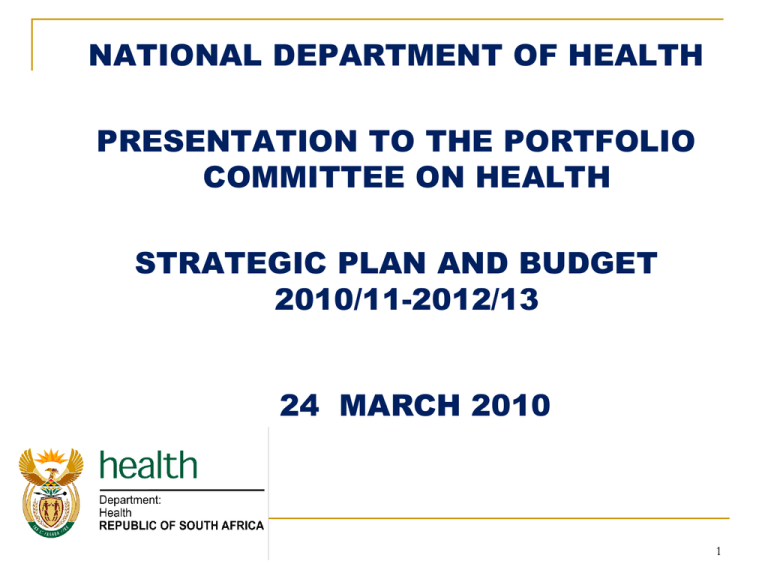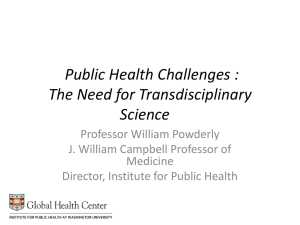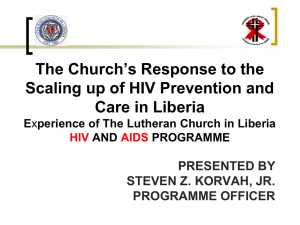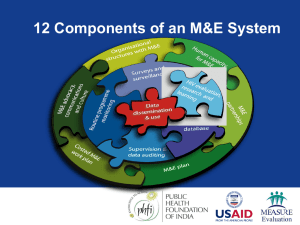key strategic interventions during 2010/11-2012/13 will
advertisement

NATIONAL DEPARTMENT OF HEALTH PRESENTATION TO THE PORTFOLIO COMMITTEE ON HEALTH STRATEGIC PLAN AND BUDGET 2010/11-2012/13 24 MARCH 2010 1 STRUCTURE OF PRESENTATION 1. VISION AND MISSION 2. CONTEXT OF HEALTH SERVICE DELIVERY 3. HEALTH SECTOR RESPONSE 4. IMPLEMENTING THE HEALTH SECTOR’S RESPONSE DURING 2010/11-2012/13 5. MAJOR HEALTH CAMPAIGNS FORTHCOMING 6. RESOURCE ENVELOPE FOR IMPLEMENTING THE NATIONAL DOH PLANS FOR 2010/11-2012/13 7. MTEF ALLOCATIONS FOR 2010/11-2012/13 2 STRUCTURE OF PRESENTATION 8. OVERALL BUDGET ALLOCATION PER PROGRAMME (INCLUDING CONDITIONAL GRANTS) 9. OBSERVATIONS FROM THE MEDIUM TERM EXPENDITURE FRAMEWORK (MTEF) ALLOCATIONS FOR CONDITIONAL GRANTS 10. OVERALL BUDGET ALLOCATION PER PROGRAMME (EXCLUDING CONDITIONAL GRANTS) 11. MTEF ALLOCATIONS FOR CONDITIONAL GRANTS 12. NEW ALLOCATIONS FOR 2010/11-2012/13: PRIORITY AREAS 13. CONCLUSION 3 1. VISION AND MISSION VISION An accessible, caring and high quality health system. MISSION To improve health status through the prevention of illnesses and the promotion of healthy lifestyles and to consistently improve the health care delivery system by focusing on access, equity, efficiency, quality and sustainability. 4 2. CONTEXT OF HEALTH SERVICE DELIVERY National DoH Strategic Plan for 2010/11-2012/13 evolves in a context of several key issues facing the health sector namely: Health is one of the 5 key priorities of government for 2009-2014; South Africa faces a quadruple Burden of Disease (BoD) consisting of: HIV & AIDS and TB; High Maternal and Child Mortality; Non-Communicable Diseases and; Violence and Injuries; In 2007, South Africa had only 0.7% of the world’s population, but accounted for 17% (about 5.5 million people) of the global burden of HIV infections (The Lancet, August 2009); 5 2. CONTEXT OF HEALTH SERVICE DELIVERY Despite spending 8.7% of its GDP on health, and spending more on health than any other African country, South Africa is one of only 12 countries in which mortality rates for children younger than 5 years have increased since 1990 (The Lancet, August 2009); Life expectancy in South Africa has declined: For the period 1985-1994, StatsSA estimated life expectancy at birth at about 54,12 years for males and 64,38 years for females. For 1996, the estimates were 52,11 years for males and 61,6 years for females. The first set of figures provided a pre-AIDS baseline, whilst the second set reflected a period when HIV/AIDS was emerging as a key health issue. In 2009, StatsSA estimated life expectancy at 53.5 years for males and 57.2 years for females (StatsSSA, 2009) Urgent need exists to accelerate progress towards health-related Millennium Development Goals (MDGs); South Africa has a predominantly curative health system; which places less emphasis on disease prevention and health promotion; Urgent need exists to enhance Health Systems Effectiveness at all levels. 6 2. CONTEXT OF HEALTH SERVICE DELIVERY INDICATOR BASELINE 2009 Life Expectancy at Birth 53.5 years for males (StatsSSA, 2009) 57.2 year for females (StatsSSA, 2009) Child Mortality 69 per 1,000 live births Maternal Mortality Ratio 400-625 per 100,000 live births HIV Prevalence (amongst 15-24 year old pregnant women) 21,7% Mother to child transmission rate of HIV 10% Percentage of eligible HIV positive women initiated on ART 37% TB Cure Rate 64% Percentage of HIV-TB co-infected patients who are on ART 30% DATA SOURCES: STATSSA: STATISTICAL RELEASES P0302, MID YEAR POPULAITON ESTIMATES 2009; PRESIDENCY (2010): IMPROVING GOVERNMENT’S PERFORMANCE, DEVELOPING THE MTSF INTO A SET OF KEY OUTCOMES WITH MEASURABLE OUTPUTS AND AGREED INTERVENTIONS; STATISTICS SOUTH AFRICA, 7 3. HEALTH SECTOR RESPONSE 3.1. THE 10 POINT PLAN OF THE HEALTH SECTOR 2009-2014 (i) Provision of Strategic leadership and creation of a social compact for better health outcomes; (ii) Implementation of National Health Insurance (NHI); (iii) Improving the Quality of Health Services; (iv) Overhauling the health care system by: (a) Refocusing on Primary Health Care (PHC); (b) Improving the functionality and management of the Health System (v) Improving Human Resources, Planning, Development and Management; 8 3. HEALTH SECTOR RESPONSE 3.1. THE 10 POINT PLAN OF THE HEALTH SECTOR 2009-2014 (vi) Revitalisation of infrastructure, with a focus on: (a) Accelerating the delivery of health infrastructure through Public Private Partnerships (PPPs); (b) Revitalising Primary Level Facilities; (c) Accelerating the delivery of Health Technology and Information Communication Technology (ICT) infrastructure (vii) Accelerated implementation of HIV and AIDS and Sexually Transmitted Infections National Strategic Plan, 2007-2011 and reduction of mortality due to TB and associated diseases; (viii) Mass mobilisation for better health for the population; (ix) Review of the Drug Policy; and (x) Strengthening Research and Development 9 3. HEALTH SECTOR RESPONSE 3.2. THE OUTCOME-BASED MTSF 2010-2014 (i) Increased Life Expectancy at Birth (ii) Reduced Child Mortality (iii) Decreased Maternal Mortality Ratio (iv) Managing HIV Prevalence (v) Reduced the rate of HIV Infections (vi) Expanded PMTCT Programme (vii) Improved TB Case Finding (viii) Improved TB outcomes (ix) Improved access to Antiretroviral Treatment for HIV-TB co-infected patients (x) Decreased prevalence of MDR-TB 10 3. HEALTH SECTOR RESPONSE 3.2. THE OUTCOME-BASED MTSF 2010-2014 (xi) Revitalisation of Primary Health Care (xii) Improved Physical Infra-structure for Healthcare Delivery (xiii) Improved Patient Care and Satisfaction (xiv) Accreditation of health facilities for quality (xv) Enhanced Operational Management of Health Facilities (xvi) Improved access to Human Resources for Health (xvii) Improved Health Care Financing (xviii) Strengthened Health Information Systems (HIS) (xix) Improved health services for the Youth (xx) Expanded access to Home Based Care and Community Health Workers 11 3. HEALTH SECTOR RESPONSE 3.3. REQUIRED IMPROVEMENTS IN HEALTH OUTCOMES INDICATOR BASELINE 2009 Life Expectancy at Birth TARGET 2014/15 58-60 years 53.5 years for males 57.2 year for females Child Mortality 69 per 1,000 live births 30-45 per 1,000 live births Maternal Mortality Ratio 400-625 per 100,000 live births 100 per 100,000 live births HIV Prevalence (amongst 15-24 year old pregnant women) 21,7% Improved quality of life of people living with HIV and AIDS Mother to child transmission rate of HIV 10% 0% - <5% Percentage of eligible HIV positive women initiated on ART 37% All eligible pregnant women to be initiated on ART at a CD4 count of <350 or WHO stage iii or IV TB Cure Rate 64% 85% Percentage of HIV-TB coinfected patients who are on ART 30% 100% 12 4. IMPLEMENTATION OF THE HEALTH SECTOR’S RESPONSE DURING 2010/11-2012/13 4.1. INCREASING LIFE EXPECTANCY KEY STRATEGIC INTERVENTIONS DURING 2010/11-2012/13 WILL INCLUDE: Initiating on Antiretroviral Treatment (ART) all eligible people presenting with HIV and AIDS and Tuberculosis (TB) co-morbidity at a CD 4 count of 350 or less as from 01 April 2010. This is in keeping with the President’s Announcements on World AIDS Day, 01 December 2009; Increasing the number of new patients initiated on Antiretroviral Therapy (ART) to between 400,000-550,000 annually during 2010/11-2012/13; Increasing the national average TB cure rate from 64% in 2006 to 80% by 2012/13; Decreasing the incidence of malaria from 0,71 per 1000 population at risk in 2009/10 to 0.56 per 1000 population at risk in 2012/13; 13 4. IMPLEMENTATION OF THE HEALTH SECTOR’S RESPONSE DURING 2010/11-2012/13 4.2. REDUCING CHILD MORTALITY KEY STRATEGIC INTERVENTIONS DURING 2010/11-2012/13 WILL INCLUDE: Increasing the number of new child patients initiated on Antiretroviral Therapy (ART) from 38,000 in 2009/10 to between 40,000-45,000 annually during 2010/11-2012/13; Increasing the proportion of HIV positive children initiated on Cotrimoxazole prophylaxis from 6 weeks of birth from 50% in 2009/10 to 80% in 2012/13; Increasing the percentage of mothers and babies who receive post-natal care within 6 days of delivery from 20% in 2009/10 to 80% in 2012/13; Conducting Measles and Polio Campaigns in all Provinces by May 2010; Increasing the percentage of children under 1-year of age fully immunised from 88% in 2009/10 to more than 95% in 2012/13. Increasing the percentage of children under 1-year of age immunised with two new vaccines (Pneumoccocal and Rotavirus vaccines) from 40% in 2009/10 to more than 80% in 2012/13. Ensuring that School Health Services are provided in the 18 priority districts by 2010/11, and in all schools by the end of 2012/13. 14 4. IMPLEMENTATION OF THE HEALTH SECTOR’S RESPONSE DURING 2010/11-2012/13 4.3. REDUCING MATERNAL MORTALITY KEY STRATEGIC INTERVENTIONS DURING 2010/11-2012/13 WILL INCLUDE: Increasing the proportion of health facilities providing Basic Antenatal Care (BANC) from 42% in 2009/10 to 95% in 2012/13; Ensuring that 70% of primary level health facilities have health workers trained in Emergency Obstetric Care and Comprehensive Emergency Obstetric Care; Increasing the percentage of mothers and babies who receive post-natal care within 6 days of delivery from 20% in 2009/10 to 80% in 2012/13; Increasing the percentage of eligible HIV positive pregnant women placed on Highly Active Antiretroviral Therapy (HAART) from 37% in 2009/10 to 100% in 2012/13; Increasing the proportion of desginated health facilities providing Choice on Termination of Pregnancy (CTOP) from 30% in 2009/10 to 70% in 2012/13; Increasing the percentage of maternity care facilities which review maternal and perinatal deaths and address identified deficiencies from 53% in 2009/10 to 100% in 2012/13; 15 4. IMPLEMENTATION OF THE HEALTH SECTOR’S RESPONSE DURING 2010/11-2012/13 4.4. MANAGING HIV PREVALENCE KEY STRATEGIC INTERVENTIONS DURING 2010/11-2012/13 WILL INCLUDE: Implementing Health care provider-initiated Counselling and Testing in 100% of health facilities by June 2010; Increasing the proportion of pregnant women tested through Health care providerinitiated Counselling and Testing to 100% by 2010/11; Increasing the proportion of HIV patients started on Cotrimoxazole Prophylaxis from 71% in 2009/10 to 95% by 2012/13; Increasing the proportion of HIV patients started on Isoniazid Preventive Therapy (IPT) from 10% in 2009/10 to 80% in 2012/13. 16 4. IMPLEMENTATION OF THE HEALTH SECTOR’S RESPONSE DURING 2010/11-2012/13 4.5. REDUCING THE RATE OF HIV INFECTIONS KEY STRATEGIC INTERVENTIONS DURING 2010/11-2012/13 WILL INCLUDE: Scaling up condom distribution, with 1 billion male condoms distributed annually during 2010/11-2012/13, and 6 million female condoms distributed in 2010/11, which will increase to 9 million by 2012/13; NB. During the HIV Counseling and Testing (HCT) campaign, this number will increase by 1,5 billion condoms, which will be provided to the 15 million people who will undergo counselling and testing; Implementation of Youth Friendly Services (YFS), with the proportion of primary level facilities providing YFS increasing from 41% in 2009/10 to 70% in 2012/13; 17 4. IMPLEMENTATION OF THE HEALTH SECTOR’S RESPONSE DURING 2010/11-2012/13 4.5. REDUCING THE RATE OF HIV INFECTIONS KEY STRATEGIC INTERVENTIONS DURING 2010/11-2012/13 WILL INCLUDE: Increase proportion of pregnant women tested through Health care provider-initiated Counselling and Testing to 100% by 2010/11; Implementation of Information, Education and Communication (IEC) targeting high risk groups; Implementation of behaviour-change programmes, with external partners. 18 4. IMPLEMENTATION OF THE HEALTH SECTOR’S RESPONSE DURING 2010/11-2012/13 4.6. EXPANDED PMTCT PROGRAMME KEY STRATEGIC INTERVENTIONS DURING 2010/11-2012/13 WILL INCLUDE: Integrating Antenatal Care and PMTCT services; Providing PMTCT prophylaxis to pregnant women not on HAART at 14 weeks of pregnancy; Implementing Health care provider-initiated Counselling and Testing in 100% of health facilities; Improving early diagnosis of HIV-exposed infants, by increasing the proportion of HIV-exposed infants diagnosed using Dry Blood Spot-Polymerase Chain Reaction (DBS-PCR) from 70% in 2009/10 to 80% in 2012/13 19 4. IMPLEMENTATION OF THE HEALTH SECTOR’S RESPONSE DURING 2010/11-2012/13 4.7. IMPROVING NOTIFICATION OF TB CASES KEY STRATEGIC INTERVENTIONS DURING 2010/11-2012/13 WILL INCLUDE: Strengthening the implementation of the DOTS Strategy in all Districts; Increasing the number of Community Health Workers trained as DOT Supporters from 1,905 in 2009/10 to 2,500 annually during 2010/11; 2011/12 and 2012/13; Decreasing TB cases reported from 405,512 in 2010/11 to 205, 256 in 2011/12 and to 175,000 in 2012/13. Number of new TB cases reported will initially increase due to vigorous contact tracing, and then start dropping later through improved infection control and decreasing the number of patients who are infectious, through early detection and successful treatment; Fully integrating TB and HIV services by March 2011. 20 4. IMPLEMENTATION OF THE HEALTH SECTOR’S RESPONSE DURING 2010/11-2012/13 4.8. IMPROVED TB OUTCOMES KEY STRATEGIC INTERVENTIONS DURING 2010/11-2012/13 WILL INCLUDE: Training at least 3,500 health professionals in TB management annually during 2010/11; 2011/12 and 2012/13 Ensuring that all 52 Districts and 232 Sub-districts have appointed TB Coordinators; Reducing the TB defaulter rate from 7,9% in 2009/10 to 5% (or less) in 2012/13; Increasing the proportion of TB patients who successfully complete their treatment from 75% in 2009/10 to 90% in 2012/13; Increasing the TB cure rate from 64% in 2007 to >80% in 2012/13. 21 4. IMPLEMENTATION OF THE HEALTH SECTOR’S RESPONSE DURING 2010/11-2012/13 4.9. IMPROVED ACCESS TO ANTIRETROVIRAL TREATMENT FOR HIV-TB CO-INFECTED PATIENTS KEY STRATEGIC INTERVENTIONS DURING 2010/11-2012/13 WILL INCLUDE: Initiating on ART all eligible people presenting with HIV and AIDS and Tuberculosis (TB) co-morbidity at a CD4 count of 350 or less, as from 01 April 2010; Training at least 3,500 health professionals in TB management annually during 2010/11; 2011/12 and 2012/13; Increasing the proportion of HIV positive patients started on Isoniazid Preventive Therapy (IPT) from 10% in 2009/10 to 80% in 2012/13; Strengthening the integration of TB and HIV services (including provision of ART) 22 4. IMPLEMENTATION OF THE HEALTH SECTOR’S RESPONSE DURING 2010/11-2012/13 4.10. DECREASING PREVALENCE OF DRUG RESISTANT TB KEY STRATEGIC INTERVENTIONS DURING 2010/11-2012/13 WILL INCLUDE: Ensuring that by 2011/12, all 20 Drug Resistant TB Facilities appropriately implement Drug Resistant TB Guidelines (i.e. diagnose Drug Resistant TB accurately and place patients on appropriate TB regimen); Initiating on ART all eligible people presenting with HIV and AIDS and Tuberculosis (TB) co-morbidity at a CD4 count of 350 or less, as from 01 April 2010; 23 4. IMPLEMENTATION OF THE HEALTH SECTOR’S RESPONSE DURING 2010/11-2012/13 4.11. REVITALIZATION OF PRIMARY HEALTH CARE KEY STRATEGIC INTERVENTIONS DURING 2010/11-2012/13 WILL INCLUDE: • Review and strengthen the model for the delivery of health services in South Africa based on the Primary Health Care (PHC) approach by March 2011; • Strengthen PHC Teams in all 9 Provinces (and 52 Districts) to improve access to health care by 2011/12; • Complete the audit of Primary Level Services and Infrastructure by 2012/13 • Improve the governance of the District Health System, and increase number of District Health Councils established from 43 in 2009/10 to 52 in 20102/13; • Ensure that all 52 Districts have District Management Teams, with formal and written delegations by 2010/11. 24 4. IMPLEMENTATION OF THE HEALTH SECTOR’S RESPONSE DURING 2010/11-2012/13 4.12. IMPROVED INFRASTRUCTURE FOR HEALTHCARE DELIVERY KEY STRATEGIC INTERVENTIONS DURING 2010/11-2012/13 WILL INCLUDE: Placing dedicated focus on three areas of infrastructure revitalization namely: (i) Accelerating the delivery of health infrastructure through Public Private Partnerships (PPPs) especially for the construction (and refurbishment) of 5 Tertiary Hospitals namely: Nelson Mandela Academic (Eastern Cape); Chris Hani Baragwanath (Gauteng); Dr. George Mukhari (Gauteng); Limpopo Academic (Limpopo); King Edward VIII (KwaZulu-Natal); 25 4. IMPLEMENTATION OF THE HEALTH SECTOR’S RESPONSE DURING 2010/11-2012/13 4.12. IMPROVED INFRASTRUCTURE FOR HEALTHCARE DELIVERY KEY STRATEGIC INTERVENTIONS DURING 2010/11-2012/13 WILL INCLUDE: (ii) (iii) Revitalizing primary level facilities; Accelerating the delivery of Health Technology and Information Communication Technology (ICT) infrastructure. The National Health Technology (HT) Strategy and HT Standards will be finalised in 2011/12; The e-Health Agency will be established in 2010/11 to steer the development of the ICT Strategy; ICT Standards will be finalised and implemented in all 9 Provinces during 2011/12 and 2012/13. 26 4. IMPLEMENTATION OF THE HEALTH SECTOR’S RESPONSE DURING 2010/11-2012/13 4.13. IMPROVED PATIENT CARE AND SATISFACTION KEY STRATEGIC INTERVENTIONS DURING 2010/11-2012/13 WILL INCLUDE: Ensuring that 30% of the 400 public sector hospitals to conduct at least one Patient Satisfaction Survey per annum by 2010/11. This will figure grow to 60% in 2011/12 and to 90% of public sector hospitals in 2012/13. Fast-tracking improvements in six priority areas of quality of care namely: Positive and caring values and attitudes; Reduced waiting times; Improved Cleanliness; Improved patient safety; Infection prevention and control; and Availability of medicines and supplies. 27 4. IMPLEMENTATION OF THE HEALTH SECTOR’S RESPONSE DURING 2010/11-2012/13 4.13. IMPROVED PATIENT CARE AND SATISFACTION KEY STRATEGIC INTERVENTIONS DURING 2010/11-2012/13 WILL INCLUDE: In 2010/11, 50% of health facilities will produce and implement Quality Improvement Plans. Quality Improvement Plans will be produced by 60% of public health facilities in 2011/12; and by 70% of these facilities by 2012/13. Monitoring complaints from users of public health services, and ensuring that at least 75% of complaints from users of services are resolved within 25 days by 2012/13. 28 4. IMPLEMENTATION OF THE HEALTH SECTOR’S RESPONSE DURING 2010/11-2012/13 4.14. ACCREDITATION OF HEALTH FACILITIES FOR QUALITY KEY STRATEGIC INTERVENTIONS DURING 2010/11-2012/13 WILL INCLUDE: Establishing a “Quality Management and Accreditation Body” to function independently of National, Provincial Departments, but accountable to the Ministry; Amending the National Health Act of 2003 to facilitate this process, through required Cabinet and Parliamentary processes; Auditing 20% of the 4,333 public health facilities in 2010/11, to assess if they meet core standards. This figure grows to 40% in 2011/12 and to 70% by 2012/13; Accrediting 10% of health establishments (public and private) in 2010/11; 30% in 2011/12 and 65% by 2012/13. 29 4. IMPLEMENTATION OF THE HEALTH SECTOR’S RESPONSE DURING 2010/11-2012/13 4.15. ENHANCED OPERATIONAL MANAGEMENT OF HEALTH FACILITIES KEY STRATEGIC INTERVENTIONS DURING 2010/11-2012/13 WILL INCLUDE: Assessing the functionality, efficiency and appropriateness of the organisational structure of a particular hospital, and the appropriateness of the delegations for the hospital, in partnership with the Development Bank of Southern Africa (DBSA) by March 2011; Conducting a feasibility study for the establishment of a Management and Leadership Academy for Health Managers; Producing and costing a Business Plan for the development of the Management and Leadership Academy for Health Managers; by March 2011; Obtaining accreditation for the Management and Leadership Academy for Health Managers from the Council for Higher Education (CHE) and South African Qualifications Authority (SAQA) by March 2012, and accepting the first group of students by February 2013. 30 4. IMPLEMENTATION OF THE HEALTH SECTOR’S RESPONSE DURING 2010/11-2012/13 4.16. IMPROVED ACCESS TO HUMAN RESOURCES FOR HEALTH KEY STRATEGIC INTERVENTIONS DURING 2010/11-2012/13 WILL INCLUDE: Producing a revised Human Resources for Health Plan by the end of 2010/11, which will: Quantify the country’s needs for health care workers, and specify training targets for the next 5 years; Outline strategies for increasing the production of key PHC workers such as Environmental Health Practitioners (EHPs), Infection Control Workers and diverse categories of Mid-level workers; Reflect comprehensive strategies for the recruitment and retention of health professionals; including urgent collaboration with countries that have excess of these professionals, as well as strategies to strengthening the training platform; Reflect an appropriate balance between health professionals and administrative personnel. Supporting Provincial DoHs to produce their own Human Resources for Health Plans; 31 4. IMPLEMENTATION OF THE HEALTH SECTOR’S RESPONSE DURING 2010/11-2012/13 4.17. IMPROVED HEALTH CARE FINANCING KEY STRATEGIC INTERVENTIONS DURING 2010/11-2012/13 WILL INCLUDE: Improving financial management by establishing a dedicated Provincial Finance and Budget Support Unit in the National DoH; Producing draft NHI legislation for submission to Cabinet and Parliament by March 2011. 32 4. IMPLEMENTATION OF THE HEALTH SECTOR’S RESPONSE DURING 2010/11-2012/13 4.18. STRENGTHENING HEALTH INFORMATION SYSTEMS (HIS) KEY STRATEGIC INTERVENTIONS DURING 2010/11-2012/13 WILL INCLUDE: Developing and implementing an ICT Strategy; Developing ICT Standards and ensuring implementation in all 9 Provinces during 2011/12 and 2012/13; Establishing an eHealth Agency by 2010/11 Establishing a Disease Control Hub by 2010/11; Implementing the Primary Health Care Information System in 36 Districts by 2012/13. 33 4. IMPLEMENTATION OF THE HEALTH SECTOR’S RESPONSE DURING 2010/11-2012/13 4.19. IMPROVED HEALTH SERVICES FOR THE YOUTH KEY STRATEGIC INTERVENTIONS DURING 2010/11-2012/13 WILL INCLUDE: Finalising the Youth Health Strategy by March 2011, and strengthening the provision of life skills education to youth; Strengthening the implementation of Youth Friendly Services (YFS), with the proportion of primary level facilities providing YFS increasing from 41% in 2009/10 to 70% in 2012/13; Finalising and implementing the Mini Drug Master Plan by 2010/11, to reduce the usage of illicit substances, especially by the youth; 34 4. IMPLEMENTATION OF THE HEALTH SECTOR’S RESPONSE DURING 2010/11-2012/13 4.20. EXPANDED ACCESS TO HOME BASED CARE AND COMMUNITY HEALTH WORKERS KEY STRATEGIC INTERVENTIONS DURING 2010/11-2012/13 WILL INCLUDE: Finalising the policy on Community Health Workers in conjunction with the Departments of Social Development and Local Government and Traditional Affairs; Developing a strategy for expanding access to Home and Community-based Care (HCBC); Standardising the training curriculum and conditions of service of Community Health Workers. 35 5. MAJOR HEALTH CAMPAIGNS FORTHCOMING Kick TB 2010 – starts on 26 March 2010, and ends in March 2011; H1N1 Campaign - starts on 05 April 2010, and ends on 31 May 2010; Measles and Polio Vaccination Campaign - starts on 12 April 2010 and ends on 23 April 2010; HIV Counseling and Testing (HCT) – starts on 15 April 2010, and ends in June 2011; Second round of Polio Vaccination Campaign runs from 24 to 28 May 2010. 36 6. RESOURCE ENVELOPE FOR IMPLEMENTING THE NATIONAL DOH PLANS FOR 2010/11-2012/13 In line with National Treasury’s request to all government Departments, cost saving measures were identified across the Department to improve cost efficiency on the utilization of funds for the delivery of services; Focus areas were on expenditure related to catering and entertainment, traveling costs both air and road (local and international), conferencing, printing and stationery, venues and facilities as well as the utilization of consultants; Discounted efficiency savings of R47.8 million in 2010/11, R51 million in 2011/12 and R54.5 million were identified in selected goods and services items as indicated above. 37 7. MTEF ALLOCATION FOR 2010/11-2012/13 Original MTEF Allocation MTEF Allocations 2010/11 2011/12 2012/13 R' 000 R' 000 R' 000 19,614,027 20,862,795 21,900,415 1,601,254 1,690,973 1,770,001 18,012,773 19,171,822 20,130,414 National Tertiary Services Grant 7,398,000 7,798,878 8,188,822 Comprehensive HIV and AIDS Grant 4,311,757 4,632,962 4,864,610 Hospital Revitalization Grant 3,880,667 4,172,292 4,380,907 556,962 590,380 619,899 1,865,387 1,977,310 2,076,176 90,723 96,102 98,791 -47,765 -50,967 -54,474 1,840,000 2,800,000 3,900,000 21,496,985 23,707,930 25,844,732 Departmental baseline Conditional Grants to Provincial Government Forensic Pathology Services Grant Health Professions Training and Development Grant Additional Funds Allocated to Baseline Adjustments to Baseline Additional Funds Allocated to Conditional Grants TOTAL MTEF ALLOCATIONS 38 8. OVERALL BUDGET ALLOCATION PER PROGRAMME (INCLUDING CONDITIONAL GRANTS) 2009/10 R'000 2010/11 R'000 2011/12 R'000 2012/13 R'000 % Increas e from 2009/10 2010/11 260,437 264,834 299,880 330,921 2% 13% 8,774,402 10,147,611 28% 20% 426,123 454,171 3% 5% Programme 1. Administration 2. Strategic Health Programmes 3. Health Planning and Monitoring 4. Health Human Resources Management and Development 5. Health Services 6. International Trade and Regulation Total 5,688,253 393,449 7,294,902 406,933 % Increas e from 2010/112012/13 1,798,974 1,897,051 2,011,691 2,111,830 5% 6% 9,794,099 11,528,757 12,083,474 12,681,711 18% 5%. 104,508 112,360 118,488 16% 8% 21,496,985 23,707,930 25,844,732 19% 10% Relations, Health Health Product 90,247 18,025,459 39 9. OBSERVATIONS FROM MTEF ALLOCATIONS The Department’s overall budget has increased by 19% from 2009/10 to 2010/11. The increase for subsequent MTEF outer years 2010/11– 2012/2013 is 10%. It should be noted that despite these increases, for the National DoH there is a 6% decrease between 2009/10 and 2010/11 below the inflation rate. The increase indicated is largely for conditional grants, especially for the HIV and AIDS Grant. Other grants received an inflationary increase. Health conditional grants account for +/- 95% of total National Department of Health budget. 40 10. OVERALL BUDGET ALLOCATION PER PROGRAMME (EXCLUDING CONDITIONAL GRANTS) 2009/10 R'000 260,437 Strategic Health Programmes 863,198 Health Planning and Monitoring 396,449 Health Human Resources Management and Development Health Services International Relations, Health Trade and Health Product Regulation Total 39,175 96,697 90,247 1,746,203 % Increase from 2010/112012/13 2010/11 R'000 2011/12 R'000 2012/13 R'000 264,834 299,880 330,921 2% 20% 726,183 751,060 763,102 -16% 5% 406,933 426,123 454,171 3% 10% 31,664 34,381 35,654 -19% 11% 110,090 112,304 111,982 14% 2% 104,508 112,360 118,488 16% 12% 1,644,212 1,736,108 1,814,318 -6% 9% Programme Administration % Increase from 2009/102010/11 10. OVERALL BUDGET ALLOCATION PER PROGRAMME (EXCLUDING CONDITIONAL GRANTS) (CONT.) The negative growth under programme two – Strategic Health Programmes is due to once off allocation of R160m for the H1N1 outbreak. The negative growth under programme four – Human Resources and Management Development, is due to once off allocation of R10m for the audit of Nursing Colleges project. 10. OVERALL BUDGET ALLOCATION PER PROGRAMME (EXCLUDING CONDITIONAL GRANTS) (CONT.) The increase in the Health Services programme is largely for the two Provincial conditional grants, i.e National Tertiary Services Grant (NTSG) and the Hospital Revitalization Grant. The increase in the International Relations, Health Trade and Health Product Regulation programme is largely to support the establishment of the new medicines regulatory agency, develop IT systems and reduce backlogs. 43 11. MTEF ALLOCATIONS FOR CONDITIONAL GRANTS Conditional Grants 2009/10 R’000 2010/11 R'000 2011/12 R'000 Comprehensive HIV and AIDS Grant 4,376,186 6,011,757 Forensic Pathology Services Grant 501,869 556,962 Health Professions Training and Development Grant 1,759,799 1,865,387 1,977,310 2,076,176 Hospital Revitalization Grant 3,370,203 4,020,667 4,172,292 4,380,907 National Tertiary Services Grant 6,614,442 7,398,000 7,798,878 8,188,822 Total 16,622,499 19,852,773 7,432,962 590,380 2012/13 R'000 8,764,610 619,899 21,971,822 24,030,414 44 12. NEW ALLOCATIONS FOR 2010/11-2012/13: PRIORITY AREAS New allocation of R8,672 billion over three years of which: R1.883 billion is for 2010/11; R2.845 billion for 2011/12 and R3.944 billion for 2012/13, New allocations are for spending on the following policy priorities, including transfers to public entities: 1. Comprehensive HIV and AIDS Conditional Grant : R1.7 billion for 2010/11 R2.8 billion for 2011/12 and R3.9 billion for 2012/13, in order to expand treatment and to commence treatment for all patients of sub-groups ( HIV/TB; Antenatal Women and Newborn babies) at CD4 level of 350 or less. 45 12. NEW ALLOCATIONS FOR 2010/11-2012/13: PRIORITY AREAS 2. Hospital Revitalization Conditional Grant: R140 million for Mitchell’s Plain Hospital. 3. Office of Standards Compliance (OSC): An additional amount of R2 million for 2010/11; R8 million for 2011/12;and R18 million for 2012/13, for the Quality Assurance Programme. This is to continue to build up all aspects of the functioning of the OSC and increase the number of hospitals audited. 46 12. NEW ALLOCATIONS FOR 2010/11-2012/13: PRIORITY AREAS 4. Establishment of a Provincial Finance and Budget Support Unit: R2 million for 2010/11; R4 million for 2011/12; and R6 million for 2012/13, to build up internal capacity to monitor and support provinces. 5. Personnel shortfall: R22 million for 2010/11; R24 million for 2011/12; and R30 million for 2012/13, for Compensation of Employees to stabilize personnel expenditure. 47 12. NEW ALLOCATIONS FOR 2010/11-2012/13: PRIORITY AREAS 6. Stabilize the Forensic Chemistry Laboratories: R2 million for 2010/11 R3 million for 2011/12; and R5 million for 2012/13, to address backlogs in these laboratories. 7. Development of new hospital reimbursement mechanism linked with case mix: R1 million per financial year over the MTEF period, to develop a hospital re-imbursement tool. 48 12. 9. NEW ALLOCATIONS FOR 2010/11-2012/13: PRIORITY AREAS Measles and Polio Vaccination Campaign: R30m for 2010/11 and R20m for 2011/12 10. Emergency Medical Services (EMS) 2010: R13m for 2010/11 49 13. CONCLUSION National DoH Strategic Plan 2010/11-2012/13 reflects interventions to improve health service delivery and improve health outcomes for all South Africans. National DoH Strategic Plan 2010/11-2012/13 reflects ambitious targets - Health is one of 5 key priorities of Government for 2009-2014. A sector wide plan will be produced by end of May 2010, which will reflect the contribution of the entire sector - National and 9 Provincial DoHs - to the achievement of the 20 deliverables outlined in the foregoing sections. Despite the growth in the resource allocation for conditional grants (especially for HIV and AIDS), the overall allocation for the National Department for Operational costs declines by 6%. This means we must do more with less, without compromising quality; Where possible, donor funding will have to be mobilised, managed appropriately, and strategies developed to ensure sustainability of donor funded projects. 50





